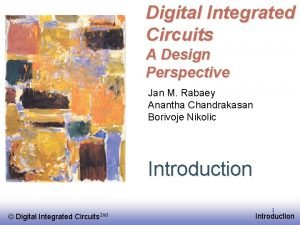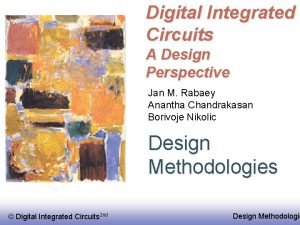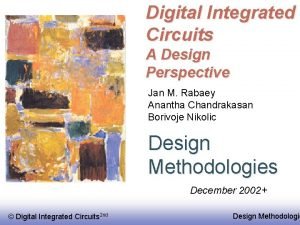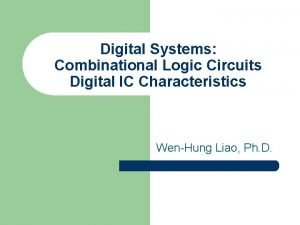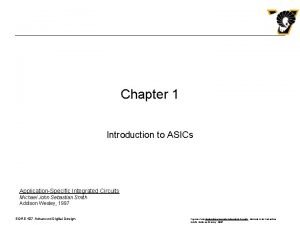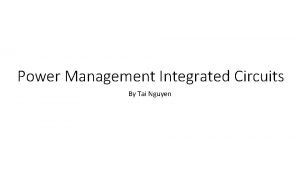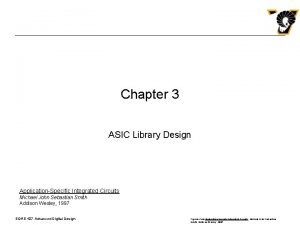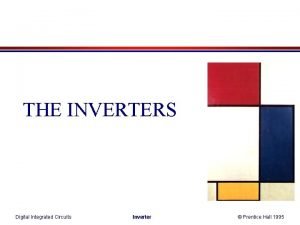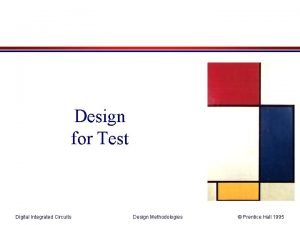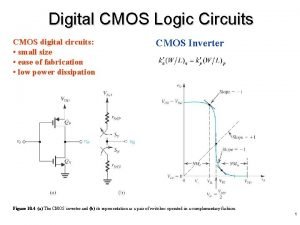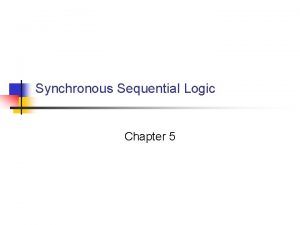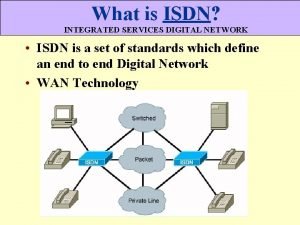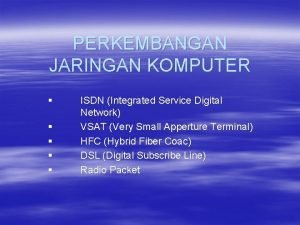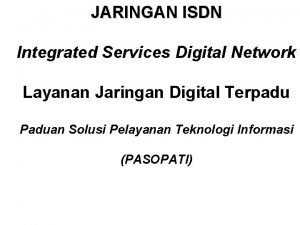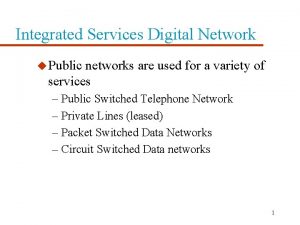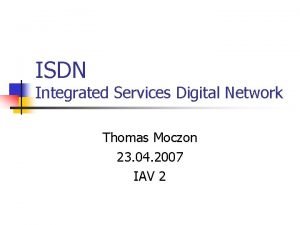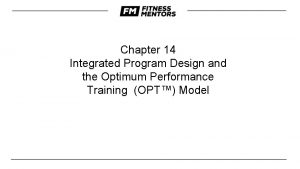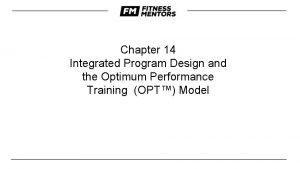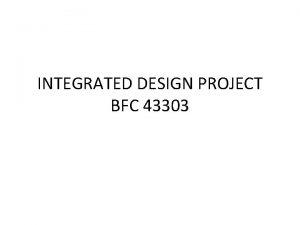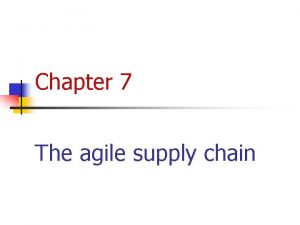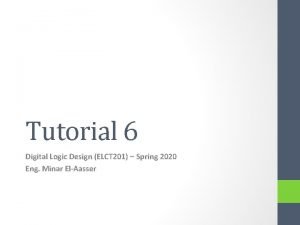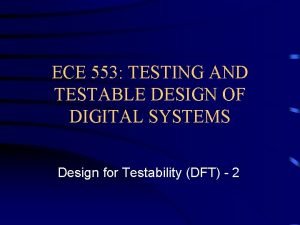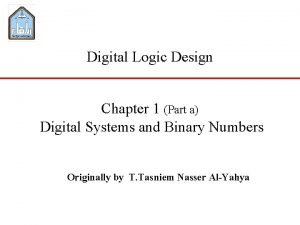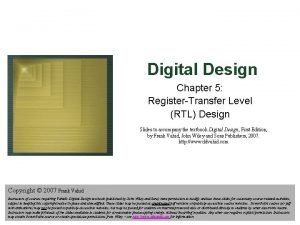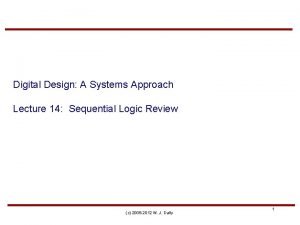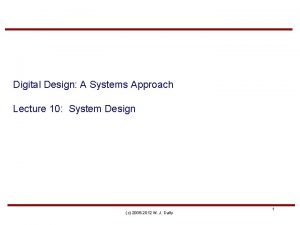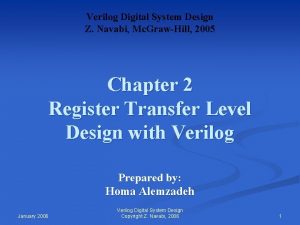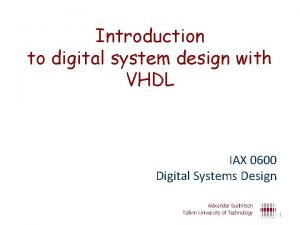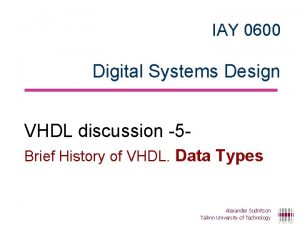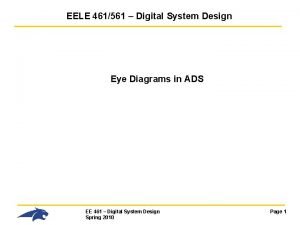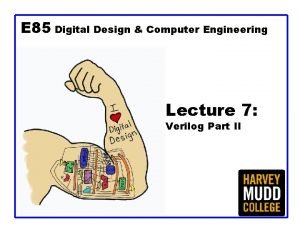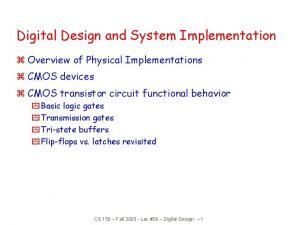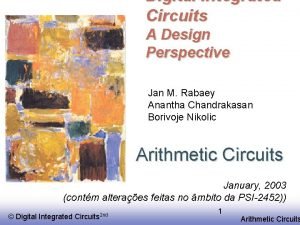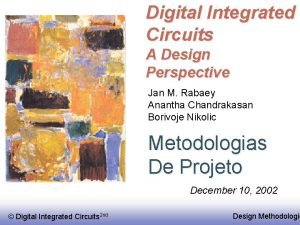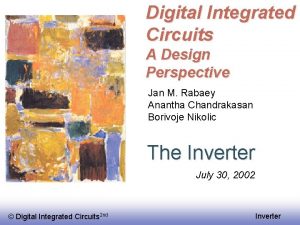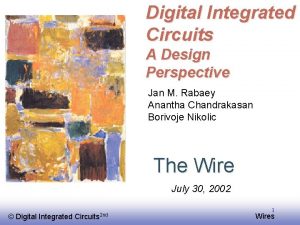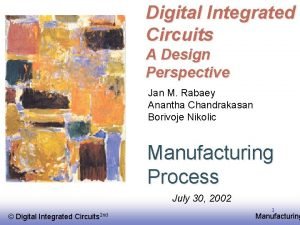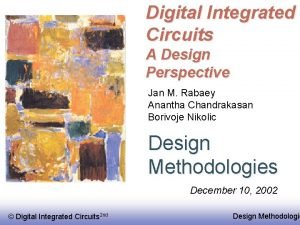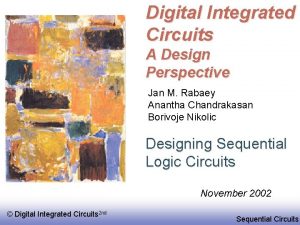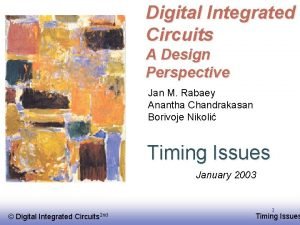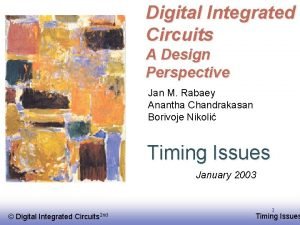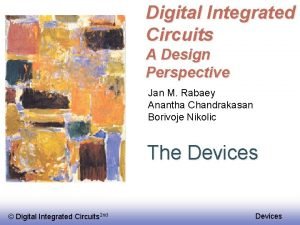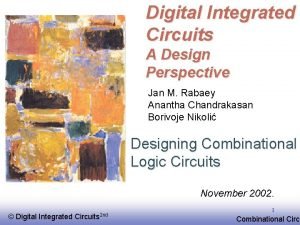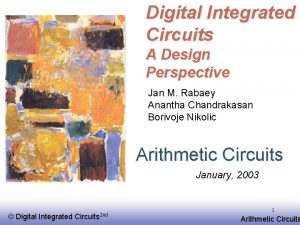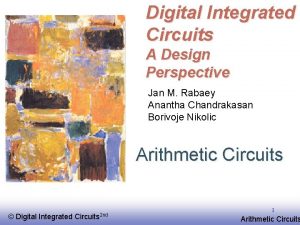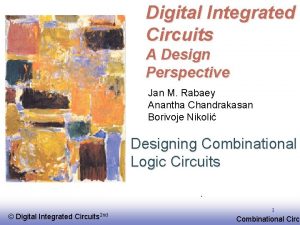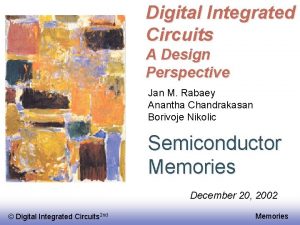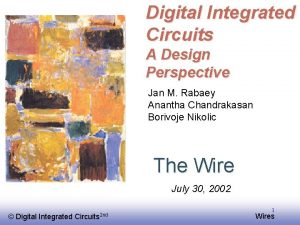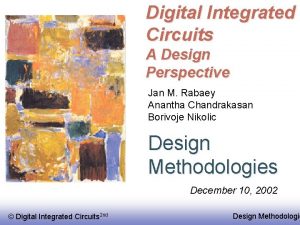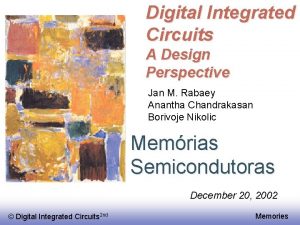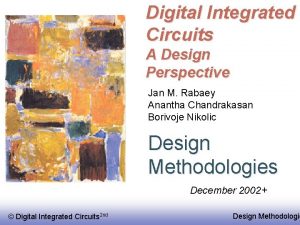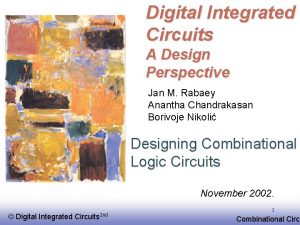Digital Integrated Circuits A Design Perspective Jan M























































- Slides: 55

Digital Integrated Circuits A Design Perspective Jan M. Rabaey Anantha Chandrakasan Borivoje Nikolic The Devices July 30, 2002 © Digital Integrated Circuits 2 nd Devices

Goal of this chapter Present intuitive understanding of device operation q Introduction of basic device equations q Introduction of models for manual analysis q Introduction of models for SPICE simulation q Analysis of secondary and deep-submicron effects q Future trends q © Digital Integrated Circuits 2 nd Devices

The Diode B A Al Si. O 2 p n Cross-section of pn-junction in an IC process A p Al A n B One-dimensional representation B diode symbol Mostly occurring as parasitic element in Digital ICs © Digital Integrated Circuits 2 nd Devices

Depletion Region © Digital Integrated Circuits 2 nd Devices

Diode Current © Digital Integrated Circuits 2 nd Devices

Forward Bias Typically avoided in Digital ICs © Digital Integrated Circuits 2 nd Devices

Reverse Bias The Dominant Operation Mode © Digital Integrated Circuits 2 nd Devices

Models for Manual Analysis © Digital Integrated Circuits 2 nd Devices

Junction Capacitance © Digital Integrated Circuits 2 nd Devices

Diffusion Capacitance © Digital Integrated Circuits 2 nd Devices

Secondary Effects ID (A) 0. 1 0 – 0. 1 – 25. 0 – 15. 0 – 5. 0 0 5. 0 VD (V) Avalanche Breakdown © Digital Integrated Circuits 2 nd Devices

Diode Model © Digital Integrated Circuits 2 nd Devices

SPICE Parameters © Digital Integrated Circuits 2 nd Devices

What is a Transistor? A Switch! An MOS Transistor |VGS| © Digital Integrated Circuits 2 nd Devices

The MOS Transistor Polysilicon © Digital Integrated Circuits 2 nd Aluminum Devices

MOS Transistors Types and Symbols D D G G S S NMOS Enhancement NMOS Depletion D G G S PMOS Enhancement © Digital Integrated Circuits 2 nd D B S NMOS with Bulk Contact Devices

Threshold Voltage: Concept © Digital Integrated Circuits 2 nd Devices

The Threshold Voltage © Digital Integrated Circuits 2 nd Devices

The Body Effect © Digital Integrated Circuits 2 nd Devices

Current-Voltage Relations A good ol’ transistor 6 x 10 -4 VGS= 2. 5 V 5 Resistive Saturation 4 ID (A) VGS= 2. 0 V 3 VDS = VGS - VT 2 VGS= 1. 5 V 1 0 Quadratic Relationship VGS= 1. 0 V 0 0. 5 1 1. 5 2 2. 5 VDS (V) © Digital Integrated Circuits 2 nd Devices

Transistor in Linear © Digital Integrated Circuits 2 nd Devices

Transistor in Saturation Pinch-off © Digital Integrated Circuits 2 nd Devices

Current-Voltage Relations Long-Channel Device © Digital Integrated Circuits 2 nd Devices

A model for manual analysis © Digital Integrated Circuits 2 nd Devices

Current-Voltage Relations The Deep-Submicron Era 2. 5 x 10 -4 VGS= 2. 5 V Early Saturation 2 VGS= 2. 0 V ID (A) 1. 5 VGS= 1. 5 V 1 0. 5 0 Linear Relationship VGS= 1. 0 V 0 0. 5 1 1. 5 2 2. 5 VDS (V) © Digital Integrated Circuits 2 nd Devices

u n (m/s) Velocity Saturation usat = 105 Constant velocity Constant mobility (slope = µ) xc = 1. 5 © Digital Integrated Circuits 2 nd x (V/µm) Devices

Perspective ID Long-channel device VGS = VDD Short-channel device V DSAT © Digital Integrated Circuits 2 nd VGS - V T VDS Devices

ID versus VGS -4 6 x 10 -4 x 10 2. 5 5 2 4 linear quadratic ID (A) 1. 5 3 1 2 0. 5 1 quadratic 0 0 0. 5 1 1. 5 VGS(V) Long Channel © Digital Integrated Circuits 2 nd 2 2. 5 0 0 0. 5 1 1. 5 2 2. 5 VGS(V) Short Channel Devices

ID versus VDS -4 6 -4 x 10 VGS= 2. 5 V x 10 2. 5 VGS= 2. 5 V 5 2 Resistive Saturation ID (A) VGS= 2. 0 V 3 VDS = VGS - VT 2 1 VGS= 1. 5 V 0. 5 VGS= 1. 0 V VGS= 1. 5 V 1 0 0 VGS= 2. 0 V 1. 5 ID (A) 4 VGS= 1. 0 V 0. 5 1 VDS(V) 1. 5 Long Channel © Digital Integrated Circuits 2 nd 2 2. 5 0 0 0. 5 1 VDS(V) 1. 5 2 2. 5 Short Channel Devices

A unified model for manual analysis G S D B © Digital Integrated Circuits 2 nd Devices

Simple Model versus SPICE 2. 5 x 10 -4 VDS=VDSAT 2 Velocity Saturated ID (A) 1. 5 Linear 1 VDSAT=VGT 0. 5 VDS=VGT 0 0 0. 5 Saturated 1 1. 5 2 2. 5 VDS (V) © Digital Integrated Circuits 2 nd Devices

A PMOS Transistor -4 0 x 10 VGS = -1. 0 V -0. 2 VGS = -1. 5 V ID (A) -0. 4 -0. 6 -0. 8 -1 -2. 5 VGS = -2. 0 V Assume all variables negative! VGS = -2. 5 V -2 -1. 5 -1 -0. 5 0 VDS (V) © Digital Integrated Circuits 2 nd Devices

Transistor Model for Manual Analysis © Digital Integrated Circuits 2 nd Devices

The Transistor as a Switch © Digital Integrated Circuits 2 nd Devices

The Transistor as a Switch © Digital Integrated Circuits 2 nd Devices

The Transistor as a Switch © Digital Integrated Circuits 2 nd Devices

MOS Capacitances Dynamic Behavior © Digital Integrated Circuits 2 nd Devices

Dynamic Behavior of MOS Transistor © Digital Integrated Circuits 2 nd Devices

The Gate Capacitance Polysilicon gate Source xd n+ xd Ld W Drain n+ Gate-bulk overlap Top view Gate oxide tox n+ L n+ Cross section © Digital Integrated Circuits 2 nd Devices

Gate Capacitance Cut-off Resistive Saturation Most important regions in digital design: saturation and cut-off © Digital Integrated Circuits 2 nd Devices

Gate Capacitance as a function of VGS (with VDS = 0) © Digital Integrated Circuits 2 nd Capacitance as a function of the degree of saturation Devices

Measuring the Gate Cap © Digital Integrated Circuits 2 nd Devices

Diffusion Capacitance Channel-stop implant N A 1 Side wall Source ND W Bottom xj Side wall LS © Digital Integrated Circuits 2 nd Channel Substrate N A Devices

Junction Capacitance © Digital Integrated Circuits 2 nd Devices

Linearizing the Junction Capacitance Replace non-linear capacitance by large-signal equivalent linear capacitance which displaces equal charge over voltage swing of interest © Digital Integrated Circuits 2 nd Devices

Capacitances in 0. 25 mm CMOS process © Digital Integrated Circuits 2 nd Devices

The Sub-Micron MOS Transistor q Threshold Variations q Subthreshold Conduction q Parasitic Resistances © Digital Integrated Circuits 2 nd Devices

Threshold Variations VT VT Long-channel threshold L Threshold as a function of the length (for low VDS ) © Digital Integrated Circuits 2 nd Low VDS threshold VDS Drain-induced barrier lowering (for low L) Devices

Sub-Threshold Conduction -2 The Slope Factor 10 Linear -4 10 -6 10 Quadratic ID (A) S is DVGS for ID 2/ID 1 =10 -8 10 -10 Exponential -12 VT 10 10 0 0. 5 1 1. 5 VGS (V) © Digital Integrated Circuits 2 nd 2 2. 5 Typical values for S: 60. . 100 m. V/decade Devices

Sub-Threshold ID vs VGS VDS from 0 to 0. 5 V © Digital Integrated Circuits 2 nd Devices

Sub-Threshold ID vs VDS VGS from 0 to 0. 3 V © Digital Integrated Circuits 2 nd Devices

Summary of MOSFET Operating Regions q Strong Inversion VGS > VT § Linear (Resistive) VDS < VDSAT § Saturated (Constant Current) VDSAT q Weak Inversion (Sub-Threshold) VGS VT § Exponential in VGS with linear VDS dependence © Digital Integrated Circuits 2 nd Devices

Parasitic Resistances © Digital Integrated Circuits 2 nd Devices

Latch-up © Digital Integrated Circuits 2 nd Devices

Future Perspectives 25 nm FINFET MOS transistor © Digital Integrated Circuits 2 nd Devices
 Digital integrated circuits a design perspective
Digital integrated circuits a design perspective Digital integrated circuits: a design perspective
Digital integrated circuits: a design perspective Digital integrated circuits a design perspective
Digital integrated circuits a design perspective Digital integrated circuits
Digital integrated circuits Integrated circuit
Integrated circuit Characteristics of digital ic
Characteristics of digital ic Advantages of parallel circuit over series circuit
Advantages of parallel circuit over series circuit Application specific integrated circuit price
Application specific integrated circuit price Power management integrated circuits
Power management integrated circuits Asic library
Asic library Thin and thick film integrated circuit
Thin and thick film integrated circuit Integrated circuits
Integrated circuits Integrated circuits
Integrated circuits Digital circuits
Digital circuits Troubleshooting digital circuits
Troubleshooting digital circuits Digital circuits
Digital circuits Two point perspective eye level
Two point perspective eye level Silo perspective vs business process perspective
Silo perspective vs business process perspective Ice cream
Ice cream Arsitektur isdn
Arsitektur isdn Integrated service digital network
Integrated service digital network Jelaskan konsep dasar isdn
Jelaskan konsep dasar isdn Integrated digital services network
Integrated digital services network Ntba wiki
Ntba wiki Integrated unit design
Integrated unit design Opt.model
Opt.model Opt model phases
Opt model phases Idp project for civil engineering
Idp project for civil engineering Integrated design project report example
Integrated design project report example Integrated design
Integrated design Agile supply chain characteristics
Agile supply chain characteristics 9 komponen kewargaan digital
9 komponen kewargaan digital E-commerce digital markets digital goods
E-commerce digital markets digital goods Digital data digital signals
Digital data digital signals Digital data transmission
Digital data transmission E-commerce: digital markets, digital goods
E-commerce: digital markets, digital goods Signal encoding schemes
Signal encoding schemes Healthtech ecosystem
Healthtech ecosystem Unique features of digital markets
Unique features of digital markets Information design: a unified perspective
Information design: a unified perspective Digital logic design tutorial
Digital logic design tutorial Digital design
Digital design Digital systems testing and testable design
Digital systems testing and testable design Harris & harris digital design and computer architecture
Harris & harris digital design and computer architecture Digital system design
Digital system design Rtl digital design
Rtl digital design Digital design: a systems approach
Digital design: a systems approach Digital design a system approach
Digital design a system approach Digital system design using verilog
Digital system design using verilog Digital logic design practice problems
Digital logic design practice problems Vhdl
Vhdl Vhdl
Vhdl Ads eye diagram
Ads eye diagram Digital design and computer architecture
Digital design and computer architecture Alice nissen
Alice nissen Digital design z
Digital design z
